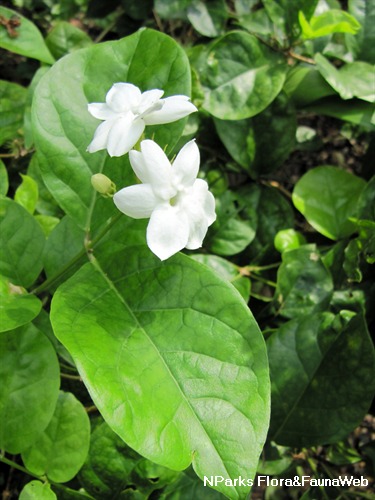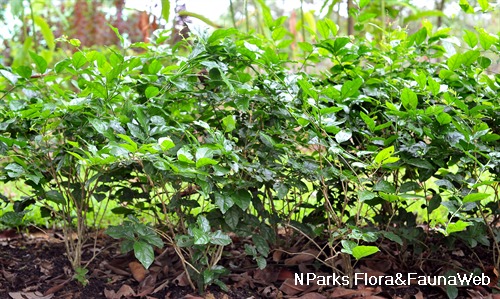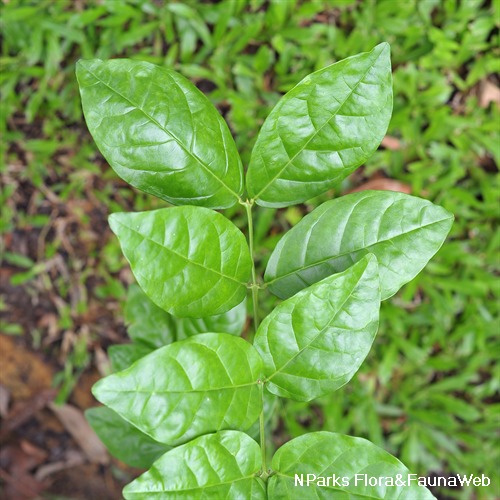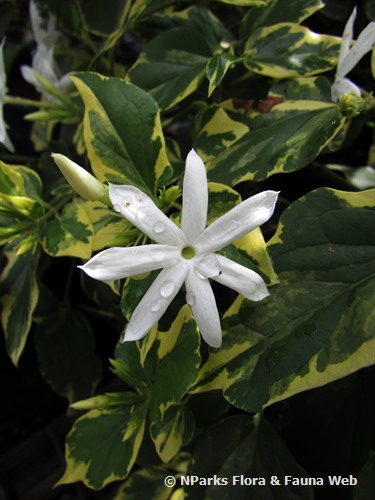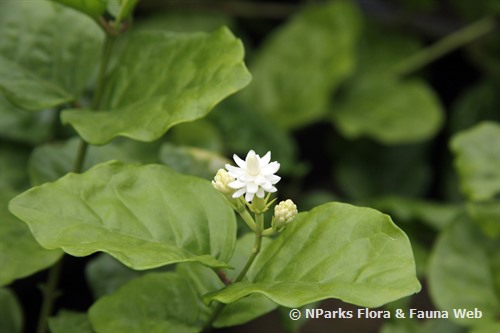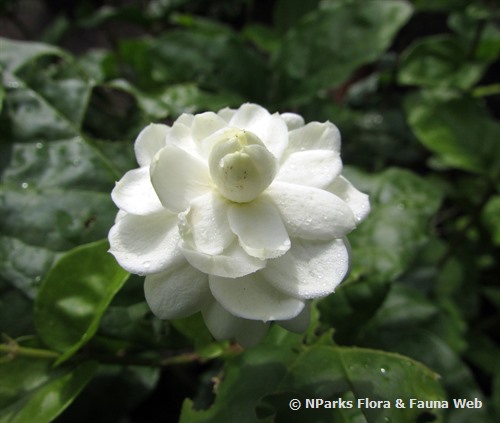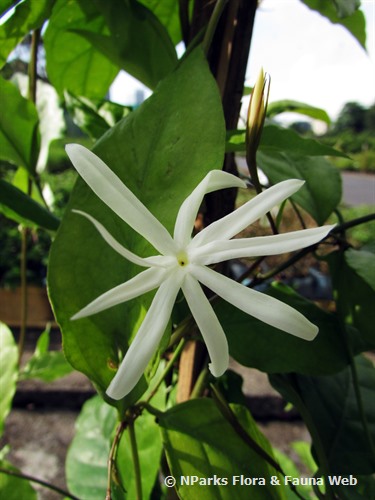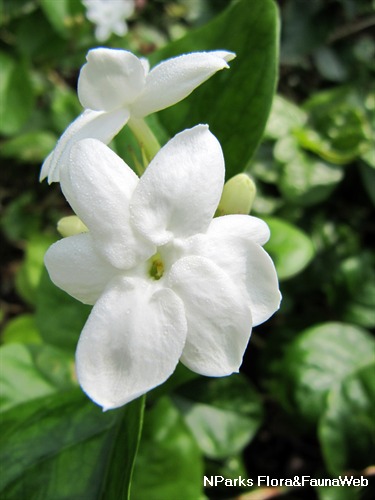
Name
Classifications and Characteristics
| Plant Division | Angiosperms (Flowering Seed Plants) (Dicotyledon) |
|---|---|
| Plant Growth Form | Shrub, Climber |
| Lifespan (in Singapore) | Perennial |
| Mode of Nutrition | Autotrophic |
| Maximum Height | 3 m |
Biogeography
| Native Distribution | India |
|---|---|
| Native Habitat | Terrestrial |
| Preferred Climate Zone | Tropical, Sub-Tropical / Monsoonal |
| Local Conservation Status | Non-native (Horticultural / Cultivated Only) |
Description and Ethnobotany
| Growth Form | A woody climber or shrub, it has a erect or twining growth form and can grow up to 3m in height. |
|---|---|
| Foliage | The leaves are arranged in opposite pairs. The leaves are shiny and broad-ovate in shape with conspicuous veins. Leaf tips are sharp. |
| Flowers | Extremely fragrant single flowers, borne in abundance. Flowers have rounded petals. Flowers appear at the tip. |
| Fruit | The fruit is a black berry surrounded by the calyx. |
| Similar | Easily confused with another cultivar J. sambac 'Arabian Nights'. 'Arabian Nights' have petals like 'Maid Of Orleans' but double-flowered (having more petals) and leaves are arranged in pairs at alternate right angles. |
| Cultivation | Grow in outdoors. This plant can grow under full sun (as a shrub) or shade (as a vine, with bigger and darker leaves). Keep plants on the dry side and do not give soggy conditions, water only when soil is dry. The soil must be well-drained and moist. Pruning helps to increase flowering as new wood produces new shoots. Fertilize monthly with a balanced fertilizer. |
| Etymology | The genus Jasminum is latinized from the Persian name, yasemin or Arabic, yasamin, for perfumed plants. The specific epithet sambac is an Arabic name, zambac. |
| Ethnobotanical Uses | Medicinal: In traditional Chinese medicine, the Jasmine flowers are brew in the form if a herbal remedy tea. It is used as a relaxant for nerves, an astringent, a sedative and as an analgesic. The oil extracted from Jasmine are used as an essential oil perfume, as well as medicinal purposes. It is used for the treatment of general stress and nervous exhaustion. Cut - Dried Flower: The flower buds are picked and sewn as lei in Hawaii. Cultural / Religious: Flowers are used in religious ceremonies. |
Landscaping Features
| Landscaping | One of the popular jasmine flowers. This bushy and compact plant does very well on window sills. |
|---|---|
| Desirable Plant Features | Ornamental Flowers, Fragrant (Flowers) |
| Landscape Uses | General, Suitable for Roadsides, Parks & Gardens, Small Gardens, Trellis / Arbour / Pergola, Container Planting |
| Thematic Landscaping | Fragrant / Aromatherapy Garden |
Plant Care and Propagation
| Light Preference | Full Sun |
|---|---|
| Water Preference | Lots of Water, Moderate Water |
| Plant Growth Rate | Fast |
| Rootzone Tolerance | Moist Soils, Well-Drained Soils |
| Pruning | Requires pruning to keep in shape. |
| Propagation Method | Seed, Stem Cutting (Semi-Hardwood) |
Foliar
| Foliage Retention | Evergreen |
|---|---|
| Mature Foliage Colour(s) | Green |
| Mature Foliage Texture(s) | Smooth, Glossy / Shiny |
| Prominent Young Flush Colour(s) | Green |
| Young Flush Texture(s) | Smooth, Glossy / Shiny |
| Foliar Type | Simple / Unifoliate |
| Foliar Arrangement Along Stem | Opposite |
| Foliar Attachment to Stem | Petiolate |
| Foliar Shape(s) | Non-Palm Foliage (Ovate) |
| Foliar Venation | Pinnate / Net |
| Foliar Margin | Entire |
| Foliar Apex - Tip | Acute |
| Foliar Base | Rounded / Obtuse |
Floral (Angiosperm)
| Flower Colour(s) | White |
|---|---|
| Flower Texture(s) | Smooth |
| Flower Grouping | Cluster / Inflorescence |
| Flower Location | Axillary |
| Individual Flower Shape | Tubular, Salverform |
| Inflorescence Type | Cyme |
| Flowering Period | Free-Flowering |
| Flowering Opening Time | Daytime |
| Flower Lifespan on Plant | 1 Day |
Image Repository
Others
| Master ID | 30034 |
|---|---|
| Species ID | 4343 |
| Flora Disclaimer | The information in this website has been compiled from reliable sources, such as reference works on medicinal plants. It is not a substitute for medical advice or treatment and NParks does not purport to provide any medical advice. Readers should always consult his/her physician before using or consuming a plant for medicinal purposes. |

